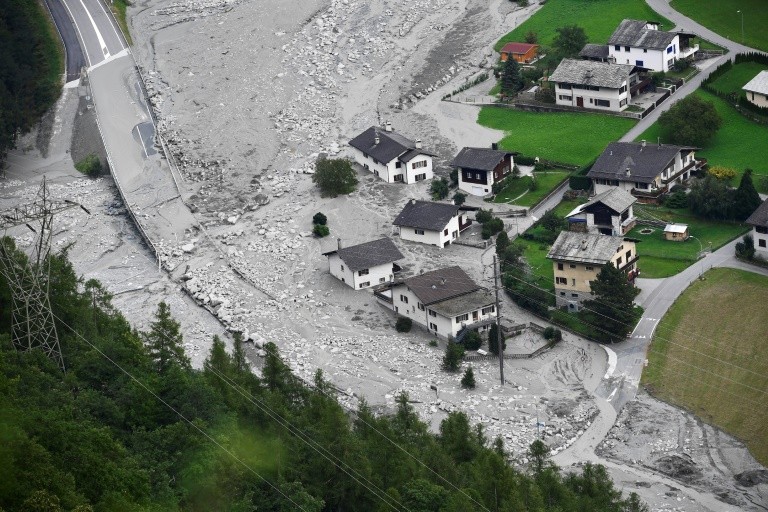Helicopter And Ground Evacuation Of Livestock: Swiss Alps Landslide Prevention

Table of Contents
Assessing Landslide Risk and Developing Evacuation Plans
Proactive risk assessment is the cornerstone of effective livestock protection in landslide-prone areas of the Swiss Alps. This involves a multi-faceted approach encompassing geological surveys, advanced weather forecasting, and meticulous analysis of historical landslide data. Understanding the specific risks faced by individual farms is crucial for creating tailored evacuation plans.
- Regular monitoring of unstable slopes: Employing advanced technologies such as satellite imagery and ground-penetrating radar allows for early detection of potential instability.
- Early warning systems utilizing sensors and meteorological data: Real-time monitoring of rainfall, soil moisture, and seismic activity provides crucial early warnings, enabling timely evacuation procedures.
- Development of detailed evacuation routes and designated assembly points: Clearly marked routes, taking into account terrain challenges and livestock needs, are crucial. Designated assembly points should be safe and easily accessible.
- Collaboration between farmers, local authorities, and emergency services: Effective communication and coordinated action are vital for swift and efficient evacuations. Regular drills and training exercises are essential.
Customized evacuation plans should be developed for each farm, considering factors such as:
- Geographical location and terrain: Steep slopes and difficult terrain may necessitate different strategies compared to more accessible areas.
- Type and number of livestock: The size and type of livestock (cows, sheep, goats) will influence the evacuation methods employed.
- Available resources: This includes access to transportation, manpower, and communication systems.
GIS mapping and sophisticated risk modelling play a crucial role in visualizing risk zones and determining the most effective evacuation strategies.
Helicopter Evacuation: A Rapid Response Solution
Helicopter evacuation offers a rapid and efficient solution, particularly in reaching remote and inaccessible areas affected by landslides. Its speed is crucial in minimizing livestock exposure to danger. Heavy-lift helicopters, capable of carrying large numbers of animals, are frequently deployed in these large-scale operations.
- Types of helicopters used: The choice of helicopter depends on the size and weight of the livestock, as well as the terrain. Heavy-lift helicopters are ideal for larger livestock, while smaller helicopters may be suitable for smaller animals or more confined areas.
- Specialized equipment and training for safe livestock handling in aerial operations: Specialized slings, crates, and experienced personnel are vital for ensuring animal welfare during aerial transport.
- Coordination with ground crews for efficient loading and unloading: Seamless coordination between ground and air crews ensures minimal stress and maximum efficiency during the evacuation process.
- Limitations of helicopter evacuation: Helicopter operations are weather-dependent and can be costly. Strong winds or poor visibility can significantly hinder operations.
Securing suitable landing zones is a critical logistical aspect of helicopter deployment. These must be large enough to accommodate the helicopter and safe for both animals and personnel.
Ground Evacuation Techniques: Alternative and Supplementary Measures
Ground evacuation techniques serve as an alternative or supplementary measure, particularly in less severe situations or when access allows. These methods often involve the use of specialized trailers, trucks, and all-terrain vehicles, chosen based on the type of livestock and terrain conditions.
- Types of transport appropriate for different animal species: Different animals require different transport methods to ensure their welfare during evacuation.
- Importance of animal welfare during ground transport: Animals should be transported carefully to minimize stress and potential injuries. Proper ventilation and sufficient space are crucial.
- Pre-planned routes and temporary holding areas: Designated routes and temporary holding areas help streamline the process and ensure the safety of animals during transport.
- The role of community support in ground-based evacuations: Community involvement is crucial, providing manpower and logistical support for efficient ground-based evacuations.
Ground evacuation complements helicopter evacuation, offering a comprehensive approach to managing livestock in landslide events. This combination ensures resilience in various scenarios.
Post-Evacuation Care and Recovery
Following an evacuation, providing adequate care for the livestock is paramount. This includes ensuring access to suitable shelter, sufficient food and water, and prompt veterinary attention.
- Veterinary checks and potential treatments for stress or injuries: Veterinary checks help assess the animals’ health and provide necessary treatment for stress-related issues or injuries sustained during the evacuation.
- Maintaining livestock records and insurance claims: Detailed records of the evacuation process and any losses incurred are essential for insurance claims and future planning.
- Assessing the damage to pastures and farm infrastructure: Assessing the extent of damage to farmland is necessary for planning recovery efforts and seeking governmental support.
- Governmental support and financial aid for farmers: Governmental support programs are vital for helping farmers recover from the economic losses associated with landslides.
Long-term strategies are needed to rebuild and enhance the resilience of alpine farming communities, including improved land management techniques and ongoing monitoring of landslide risks.
Conclusion
Effective Helicopter and Ground Evacuation of Livestock is crucial for mitigating the impact of landslides in the Swiss Alps. Proactive planning, utilizing both aerial and ground-based methods, is essential for protecting livestock and minimizing economic losses. By combining thorough risk assessments, well-defined evacuation strategies, and comprehensive post-evacuation care, farmers and authorities can significantly enhance the safety and resilience of alpine farming communities. Invest in comprehensive landslide prevention strategies and effective livestock helicopter and ground evacuation plans today to safeguard your valuable assets and ensure the future of alpine farming.

Featured Posts
-
 Qdyt Mqtl Mwzfy Alsfart Alisrayylyt Melwmat En Almshtbh Bh Ilyas Rwdryjyz
May 23, 2025
Qdyt Mqtl Mwzfy Alsfart Alisrayylyt Melwmat En Almshtbh Bh Ilyas Rwdryjyz
May 23, 2025 -
 A Photographers Story James Wiltshire And 10 Years At The Border Mail
May 23, 2025
A Photographers Story James Wiltshire And 10 Years At The Border Mail
May 23, 2025 -
 Remont Pivdennogo Mostu Pidryadniki Vartist Ta Termini
May 23, 2025
Remont Pivdennogo Mostu Pidryadniki Vartist Ta Termini
May 23, 2025 -
 The Man Utd Rival Antony Almost Joined His Story
May 23, 2025
The Man Utd Rival Antony Almost Joined His Story
May 23, 2025 -
 Blessing Muzarabani On The Path To 100 Test Wickets
May 23, 2025
Blessing Muzarabani On The Path To 100 Test Wickets
May 23, 2025
Latest Posts
-
 Office365 Security Flaw Costs Executives Millions Criminal Charged
May 23, 2025
Office365 Security Flaw Costs Executives Millions Criminal Charged
May 23, 2025 -
 Open Ai Unveils Streamlined Voice Assistant Development Tools At 2024 Event
May 23, 2025
Open Ai Unveils Streamlined Voice Assistant Development Tools At 2024 Event
May 23, 2025 -
 Millions Stolen Office365 Executive Accounts Compromised In Massive Data Breach
May 23, 2025
Millions Stolen Office365 Executive Accounts Compromised In Massive Data Breach
May 23, 2025 -
 Cybercriminal Made Millions Targeting Executive Office365 Accounts Fbi Charges
May 23, 2025
Cybercriminal Made Millions Targeting Executive Office365 Accounts Fbi Charges
May 23, 2025 -
 Federal Investigation Uncovers Millions In Losses From Office365 Hacks
May 23, 2025
Federal Investigation Uncovers Millions In Losses From Office365 Hacks
May 23, 2025
